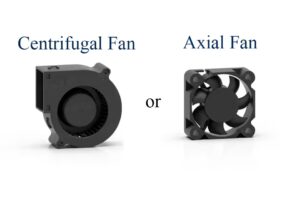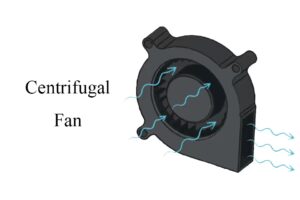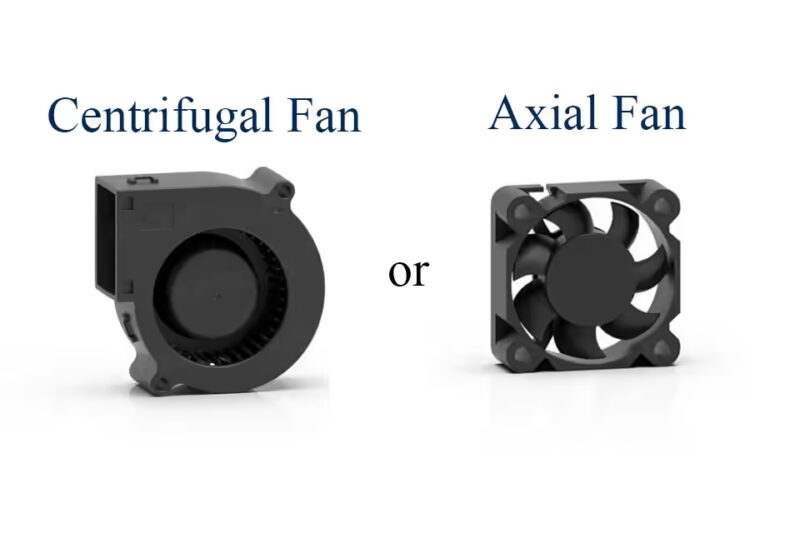In industrial and commercial settings, two primary types of fans are used for moving air and gas: centrifugal and axial fans. Though both serve the purpose of ventilation and airflow management, they operate on different principles and are suited for distinct applications.
Centrifugal fans, also known as radial fans, use centrifugal force to move air, making them ideal for high-pressure applications.
In contrast, axial fans function like a propeller, moving large volumes of air in low-pressure environments.
The choice between them hinges on specific system requirements, including airflow, pressure, and efficiency, with ongoing technological advancements continuing to shape their capabilities.

Centrifugal Fans: High-Pressure Solutions
A centrifugal fan features blades mounted on a rotating disk (or wheel) that draws air into the center and pushes it outward at a right angle. This action increases the air’s pressure and directs it through a scroll-shaped housing. This design is the key to their main advantage: the ability to generate high static pressure.
Key Advantages:
- High-Pressure Capability: They excel at overcoming resistance from ductwork, filters, and dampers, making them essential for HVAC systems and industrial ventilation.
- Versatility: Centrifugal fans are suitable for a wide range of uses, including dust collection, pneumatic material handling, and cooling electronics.
- Durability: Their design can keep the motor out of the airstream, allowing them to handle high-temperature or particulate-laden air without damage.
Centrifugal fans come in several designs, such as forward-curved for moving large air volumes at low pressure, and backward-curved, which are highly efficient for high-pressure applications with significant system resistance.
Axial Fans: High-Volume Air Movers
Axial fans utilize blades that rotate around an axis, drawing air in and discharging it in the same direction, parallel to the axis. This method is highly effective for moving large volumes of air where there is little to no resistance.
Key Advantages:
- High Airflow Volume: They are the preferred choice for applications requiring substantial air movement, such as cooling large spaces or electronic equipment.
- Compact and Space-Efficient: Their slender profile allows for seamless integration into devices and systems where space is limited, such as in server racks or consumer electronics.
- Efficiency and Noise: Axial fans generally consume less energy and produce lower noise levels than centrifugal fans, especially at lower operational speeds.
One of the standout features of axial fans is their customizability. They can be tailored with various blade configurations, sizes, and materials to meet specific industrial needs, and direct-drive models offer low maintenance by eliminating belts.

Performance and Efficiency Comparison
The fundamental difference between the two fan types lies in their performance characteristics. Centrifugal fans are built for high-pressure, lower-volume applications, while axial fans are designed for high-volume, low-pressure airflow.
Efficiency is a critical factor in fan selection, as it directly impacts operational costs. Overall fan efficiency is determined by both the fan and motor performance.
Factors such as air density, temperature, and humidity can affect a fan’s effectiveness. For optimal performance, the fan’s static pressure capabilities must be matched to the system’s requirements.
Choosing the correct fan type for the application—whether it’s overcoming the high resistance in ductwork or moving large amounts of air in an open space—is crucial for achieving significant energy savings and performance improvements.
Industry Applications
Both fan types play crucial roles across numerous industries.
Centrifugal fans are integral to:
- HVAC Systems: They provide ventilation and maintain indoor air quality in all types of buildings.
- Industrial Processes: They dissipate heat from machinery, control dust, and handle hazardous fumes in manufacturing and chemical processing.
- Data Centers:They are vital for managing heat and ensuring servers operate within optimal temperature ranges.
Axial fans are widely used in:
- Electronics Cooling: Their compact design makes them perfect for cooling densely packed electronics in computers and server racks.
- General Ventilation: They are used for circulating air in large spaces like warehouses and for agricultural purposes such as ventilating barns and greenhouses.
- Manufacturing: They provide cooling in various industrial processes that require high airflow with minimal resistance.

Conclusion
The debate between centrifugal and axial fans is not about which is superior overall, but which is best suited for a specific task. Centrifugal fans are the robust choice for systems with high resistance, while axial fans are the efficient solution for moving large volumes of air freely. As technology advances, both fan types are becoming smarter, more efficient, and more adaptable, ensuring their continued importance in managing airflow across countless applications.











